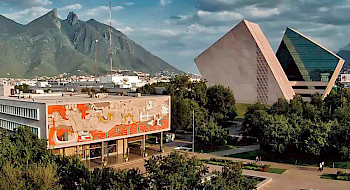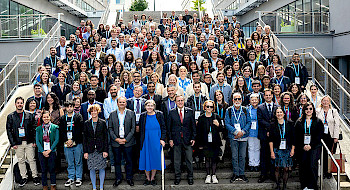
International Study Probes Trees as Unconventional Earthquake Predictors
The international citizen science initiative Tree Rhythms has a dual goal: to demonstrate that nature operates as a unified system of interacting electromagnetic fields and to investigate the feasibility of earthquake prediction through trees. A quillay tree located on the San Joaquin Campus, connected to a sensor, is the sole Chilean representative in this project, which is locally led by Professor Rosanna Ginocchio from the Faculty of Agriculture and Forestry.

photo_camera Linked to a sensor, a quillay tree positioned on the San Joaquín Campus has its electrical signals and the surrounding earth monitored. This quillay is among the 23 trees worldwide that are part of the global Tree Rhythms project, an effort of the HeartMath Institute based in California, in which UC Chile is involved. (Photo by: Paula Reyes)
Since late January 2023, hidden among the grasses of the Faculty of Agriculture and Forestry of Universidad Católica, there lies a quillay tree (Quillaja saponaria) which, at first sight, does not look very different from other specimens of its species.
However, this tree serves not only as a native representative of the sclerophyllous forest in central Chile, but is also part of an international network of trees forming the novel Tree Rhythms Citizen Science project. This initiative is spearheaded by the HeartMath Institute, headquartered in California, USA.
Tree Rhythms is part of a program to develop a new technology that uses sensors to read electrical signals in trees and the surrounding earth. As explained by Professor Rosanna Ginocchio from the Faculty of Agriculture and Forestry, "The project strives to generate new scientific knowledge by means of a collective, participatory and open research project, [involving individuals] who may not necessarily work in academic settings."
In fact, the faculty decided to participate in this initiative, through the Laboratory of Restoration, Soils and Metals (RESUME, as per its Spanish acronym), because “the two topics to be addressed in this project are very relevant at international and national level, particularly in terms of exploring whether this type of monitoring can predict earthquakes. However, in comparison to North America and Europe, South America was significantly underrepresented, with only one tree in Argentina. Given [Chile's] significant seismic activity, we thought it was a great idea to contribute to this initiative," said Professor Ginocchio, who is the local coordinator of the project. “The project's second objective, which delves into the scientific exploration of how human emotions and energies collectively impact nature, also piqued our interest as a valuable contribution.”
Trees’ Hidden Energy

While further research is required, it is well known that trees generate voltage potentials in the range of millivolts (mV) to 200 mV, as measured by electrodes placed on their trunks (as in this quillay tree). These voltage potentials are similar to those measured through electrocardiograms in humans and other animals.
In the case of plants, changes in these voltage potentials are slower (hours and days) and show 24-hour circadian rhythms. It is also known that environmental factors, such as daylight and water availability affect these cycles.
The electric current from the trees generates an electromagnetic field (biofield), which scientists believe could interact with the electromagnetic fields of people, other living beings, and the Earth. Hence, the citizen science project seeks to demonstrate that nature is a single network of interacting energy fields (according to the so-called "Electromagnetic Field Interconnectivity Hypothesis").
One of the first research questions that captivated the HeartMath Institute scientists was whether these electrical responses of trees, in a region or on the planet, correlate with events that trigger massive emotional responses in human populations, such as wars, social outbursts, and natural disasters including pandemics, floods, and megafires. To determine this, the researchers began to measure the voltage potentials of trees in various regions of the globe and invited others from around the world to participate in this research.
Earthquake Predictors?
In addition to measuring the voltage potential of the trees, the sensors detect the voltage potential between the tree's trunk and the ground where it grows. With this measurement parameter, the project seeks to determine whether trees can become low-cost sensors for earthquake prediction.
NASA researcher Friedemann Freund, who is collaborating with this initiative, posits that rocks located deep in the earth would act as large batteries when stressed by the tectonic forces of moving plates that precede earthquakes, which would affect the electrical activity of trees located in the earthquake area. Research in Japan has determined the occurrence of changes in tree voltage potentials days in advance of an earthquake, but further research is still needed.
International Network

Currently, there are 23 trees around the world where these sensors have been installed. "This collaboration enables us to engage internationally with researchers who are delving into new topics that we are beginning to explore in our laboratory, concerning cultural ecosystem services provided by nature, including trees, and the reciprocal relationships between humans and nature," said the Faculty of Agriculture and Forestry faculty member and principal investigator of the Center for Applied Ecology and Sustainability (CAPES, as per its Spanish acronym).
According to the professor, there is presently no line of study at UC Chile that directly addresses the Tree Rhythms project's aims. "That is why it is intriguing to support this initiative and begin to fund research related to these founding goals." "This research is undeniably interdisciplinary," she remarked.
Moreover: “We believe it is important to employ science in fostering a better connection with nature, thereby challenging the utilitarian and hierarchical paradigm entrenched in Western societies, particularly since the onset of the industrial revolution.”
In short, it is a reconnection with nature. "As we retreat into sprawling cities, cutting ourselves off dramatically from our natural environment, we have inadvertently paved the way for stress and its accompanying physical illnesses, as well as emotional and ultimately social imbalances. By reconnecting with nature, we can reconnect with ourselves and, from there, build truly sustainable social and economic models.”
The voltage potential records of the trunk (Channel 1) and the trunk-to-ground differential (Channel 2) of the UC Chile quillay tree can be viewed online, just like the other trees being monitored around the world (Visit: https://treerhythms.net/view).
Fluctuations in trunk voltage potentials have already been noted, including certain peaks following installation. For instance, a dip in the tree trunk potential was recorded in mid-February, coinciding with reduced foot traffic on the San Joaquin campus during the summer vacation period. Consequently, this voltage spiked in March, coinciding with the return of the UC Chile community to campus.
Within Channel 2 (tree trunk-soil), fluctuations in voltage potential have been observed throughout March, which may be connected to heightened seismic activity in the area. This is merely an initial analysis of the observed patterns in the real-time graphs. In our country's context, there is an added interest in verifying, with precise data gathered on-site, the potential connection with seismic events that might take place.





